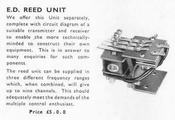On September 6, 1951, the first successful crossing of the English Channel by a model boat under radio control was made. The effort was put together by Electronic Developments Ltd, a British firm producing model engines, radio control equipment, model kits, and accessories. The first page above contains extracts from a log kept during the attempt by ED's managing director, Mr JE Ballard. The other three pages are an article describing the boat and equipment used, published in Model Maker some months prior to the attempt.
For those growing up in digital proportional era, the rig used for the crossing is worth a word or two, namely the ED Mk IV three channel transmitter and receiver. This equipment used vacuum tubes in both transmitter and receiver—no transistors in 1951. The transmitter required 120 volts, plus a separate 1.5 volt supply for the valve filaments. The receiver needed 45 volts, plus the filament supply. These were all of the old un-rechargeable lead-zinc variety where battery life and reliability was always a concern.

The Mk IV provided control of three receiver relays through amplitude modulation of the transmitter's nominal 27 MHz carrier wave with three different audio tones (the carrier was not crystal controlled). The receiver was of the super-regenerative variety—a type highly prone to interference and tedious adjustment. The demodulated tones were fed to a "reed bank". This consisted of a coil and laminated core over which were positioned thin strips of hard brass, termed "reeds", after their likeness in operation to the reed in classes of musical wind instruments. Each was cut to length so it would vibrate when the right resonant tone was fed to the coil. A simple contact on each reed activated individual relays. These switched the higher current required to operated simple servos which provided hard left and right rudder, plus sequenced motor control.
From the description of the rudder control in the Model Maker article, it sounds like it may have taken a second or two to reach full deflection, so a degree of proportional control could be achieved by "blipping" the rudder signals. The operator would however have had to be mindful of servo battery life and minimize use. Note also that the control system had no trim. Neutral was where it was, forever.
Today, we take for granted the reliability of model engines and radio control gear. The effort back in 1951 to keep the engine running as the fuel head lowered, the radio working as the batteries ran down and vibration rattled the receiver and "servos" while waves pounded the lot, not to mention crossing the Channel in a small boat while tracking an even smaller one, should not be taken lightly. This was truly a fine achievement and tribute to all involved.







